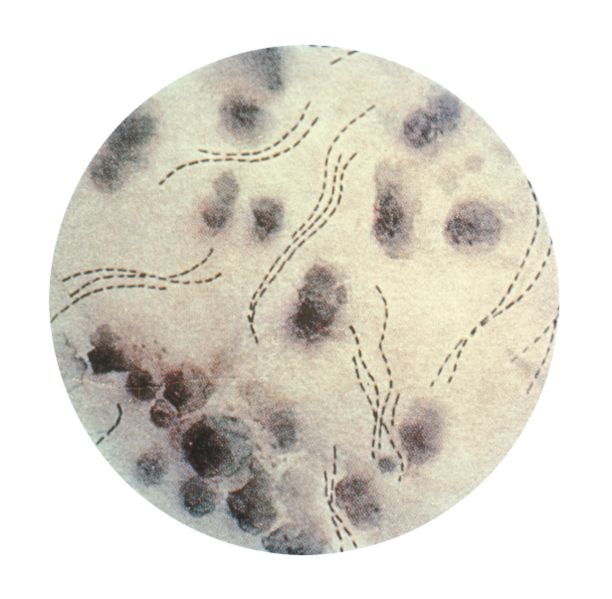Haemophilus ducreyi
|
Chancroid Microchapters |
|
Diagnosis |
|---|
|
Treatment |
|
Case Studies |
|
Haemophilus ducreyi On the Web |
|
American Roentgen Ray Society Images of Haemophilus ducreyi |
| Haemophilus ducreyi | ||||||||||||||
|---|---|---|---|---|---|---|---|---|---|---|---|---|---|---|
 Photomicrograph of H. ducreyi
| ||||||||||||||
| Scientific classification | ||||||||||||||
| ||||||||||||||
| Binomial name | ||||||||||||||
| Haemophilus ducreyi (Neveu-Lemaire 1921) Bergey et al. 1923 |
Editor-In-Chief: C. Michael Gibson, M.S., M.D. [1]; Associate Editor(s)-in-Chief: Yazan Daaboul, M.D.; Nate Michalak, B.A.; Serge Korjian M.D.
Overview
Haemophilus ducreyi is a fastidious gram-negative coccobacillus causing chancroid, a gential ulcer disease. A genetically distinct non-sexually transmitted strain may also cause cutaneous limb ulcers.
Organism
- Haemophilus ducreyi, also known as H. ducreyi, is a fastidious, Gram-negative, coccobacillus that causes the sexually transmitted disease chancroid, characterized as a genital ulcer disease.[1]
- H. ducreyi can range from short to relatively long bacilli with rounded ends, and typically grow in chains, known as a "school of fish."
- H. ducreyi was originally classified as a Haemophilus species due to its growth requirements and antigentic relatedness to other species in the genus. However, rRNA analysis indicates H. ducreyi is not a true Haemophilus but is more closely related to the Pasteurellaceae family.[2]
- Due to its complex growth requirements H. ducreyi is difficult to culture.[1]
- The genome of H. ducreyi is a single 1.7-Mb chromosome.
Human Pathogen
- H. ducreyi is an obligate human pathogen.
- H. ducreyi is typically transmitted through sexual intercourse but certain strains my also cause non-sexually transmitted cutaneous limb ulcers (CLU).
- H. ducreyi causes chancroid by secreting several virulence factors, the most well-characterized being fimbrialike protein (Flp) and H. ducreyi cytolethal distending toxin (HdCDT). Three Flps, Flp1, Flp2, and Flp3, are suspected to form pili that enable adhesion to fibroblasts and epithelial cells.[3] Active HdCDT is composed of 3 subunits and is homologous to DNase1, causing DNA double stranded breaks, which results in cell cycle arrest and apoptosis human epithelial cells, lymphocytes and fibroblasts.[4]
Strains
- Multi Locus Sequence Analysis (MLSA) of several virulence factors and housekeeping genes has identified class I and class II strains of H. ducreyi causing chancroid, a sexually transmitted genital ulcer disease.[5]
- Such analysis has identified a class I genetically distinct subclade strain of H. ducreyi that may cause non-sexually transmitted (CLU).[5]
Gallery
-
Direct smear microscopic exam revealed the presence of Haemophilus ducreyi indicative of a chancroid infection. From Public Health Image Library (PHIL). [6]
-
Photomicrograph of a rabbit blood culture showing Haemophilus ducreyi bacteria using Gram-stain technique. From Public Health Image Library (PHIL). [6]
-
Gram-negative Haemophilus ducreyi bacteria, which had been extracted from a culture. From Public Health Image Library (PHIL). [6]
-
Gram-negative Haemophilus ducreyi bacteria, which had been extracted from a culture. From Public Health Image Library (PHIL). [6]
-
Gram-negative Haemophilus ducreyi bacteria. From Public Health Image Library (PHIL). [6]
-
Gram-negative Haemophilus ducreyi bacteria (1200x mag). From Public Health Image Library (PHIL). [6]
-
Gram-negative Haemophilus ducreyi bacteria. From Public Health Image Library (PHIL). [6]
-
Gram-negative Haemophilus ducreyi bacteria. From Public Health Image Library (PHIL). [6]
-
Gram-negative Haemophilus ducreyi bacteria arranged in parallel rows. From Public Health Image Library (PHIL). [6]
-
Gram-negative Haemophilus ducreyi bacteria arranged in parallel rows. From Public Health Image Library (PHIL). [6]
References
- ↑ 1.0 1.1 Lewis, D A (2003). "Chancroid: clinical manifestations, diagnosis, and management". Sexually Transmitted Infections. 79 (1): 68–71. doi:10.1136/sti.79.1.68. ISSN 1368-4973.
- ↑ Spinola, S. M. (2002). "Immunopathogenesis of Haemophilus ducreyi Infection (Chancroid)". Infection and Immunity. 70 (4): 1667–1676. doi:10.1128/IAI.70.4.1667-1676.2002. ISSN 0019-9567.
- ↑ Spinola, S. M.; Fortney, K. R.; Katz, B. P.; Latimer, J. L.; Mock, J. R.; Vakevainen, M.; Hansen, E. J. (2003). "Haemophilus ducreyi Requires an Intact flp Gene Cluster for Virulence in Humans". Infection and Immunity. 71 (12): 7178–7182. doi:10.1128/IAI.71.12.7178-7182.2003. ISSN 0019-9567.
- ↑ Li, LiQi; Sharipo, Anatoly; Chaves-Olarte, Esteban; Masucci, Maria G.; Levitsky, Victor; Thelestam, Monica; Frisan, Teresa (2002). "The Haemophilus ducreyi cytolethal distending toxin activates sensors of DNA damage and repair complexes in proliferating and non-proliferating cells". Cellular Microbiology. 4 (2): 87–99. doi:10.1046/j.1462-5822.2002.00174.x. ISSN 1462-5814.
- ↑ 5.0 5.1 Gaston JR, Roberts SA, Humphreys TL (2015). "Molecular phylogenetic analysis of non-sexually transmitted strains of Haemophilus ducreyi". PLoS One. 10 (3): e0118613. doi:10.1371/journal.pone.0118613. PMC 4361675. PMID 25774793.
- ↑ 6.0 6.1 6.2 6.3 6.4 6.5 6.6 6.7 6.8 6.9 "Public Health Image Library (PHIL)".
![Direct smear microscopic exam revealed the presence of Haemophilus ducreyi indicative of a chancroid infection. From Public Health Image Library (PHIL). [6]](/images/3/33/Chancroid_12.jpeg)
![Photomicrograph of a rabbit blood culture showing Haemophilus ducreyi bacteria using Gram-stain technique. From Public Health Image Library (PHIL). [6]](/images/6/69/Chancroid_10.jpeg)
![Gram-negative Haemophilus ducreyi bacteria, which had been extracted from a culture. From Public Health Image Library (PHIL). [6]](/images/f/f4/Chancroid_09.jpeg)
![Gram-negative Haemophilus ducreyi bacteria, which had been extracted from a culture. From Public Health Image Library (PHIL). [6]](/images/3/33/Chancroid_08.jpeg)
![Gram-negative Haemophilus ducreyi bacteria. From Public Health Image Library (PHIL). [6]](/images/7/7e/Chancroid_07.jpeg)
![Gram-negative Haemophilus ducreyi bacteria (1200x mag). From Public Health Image Library (PHIL). [6]](/images/3/3f/Chancroid_06.jpeg)
![Gram-negative Haemophilus ducreyi bacteria. From Public Health Image Library (PHIL). [6]](/images/4/49/Chancroid_05.jpeg)
![Gram-negative Haemophilus ducreyi bacteria. From Public Health Image Library (PHIL). [6]](/images/9/9f/Chancroid_03.jpeg)
![Gram-negative Haemophilus ducreyi bacteria arranged in parallel rows. From Public Health Image Library (PHIL). [6]](/images/e/eb/Chancroid_02.jpeg)
![Gram-negative Haemophilus ducreyi bacteria arranged in parallel rows. From Public Health Image Library (PHIL). [6]](/images/3/34/Chancroid_01.jpeg)